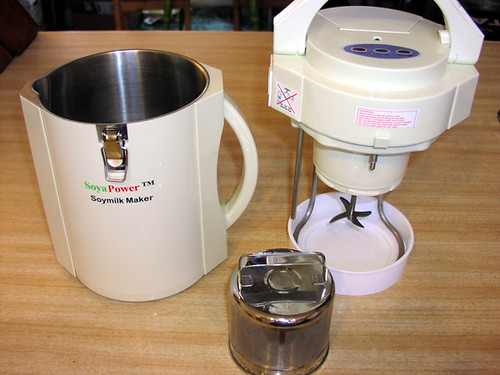
SoyaPower - our soy milk maker. The filter basket (in front) holds nuts or grains and fits around the grinding blades. The grinding part of the unit gets put into the water-filled base; the looped-metal base on the grinding part is the heating element.
My SO got this handy little contraption as a birthday present (they typically cost ~$100), and we've been happily making non-dairy milks ever since. One of the nice features of owning a soy milk maker is that you don't have to use it just to make soy milk: you can make milk out of just about any nut, grain, legume, or drupe you can fit into the grinding basket. My SO's mom took a liking to hazelnut-rice milk, and we've also made soy-barley and almond-rice milk. Additionally, you can sweeten (and otherwise flavor) the milks as much as you like. If you want to have a traditional northern-style Chinese breakfast with hot, unsweetened soy milk, you can; if you want to have sweetened almond-rice milk, you can do that too. Making the milk is also very fast - assuming you use pre-soaked nuts or grains, the unit only takes about 15 minutes to make a single batch. Since we've been making gallons of non-dairy milks recently, this seems like an appropriate end-of-the-week recipe blogging post.
It's important to remember that these non-dairy milks are drinks in-and-of themselves; they're not just a substitute drink for the dairy-intolerant. The only reason I call these drinks non-dairy milks is that there is no other good common name I know of for them (since they can be based on any or all of nuts, grains, drupes, and legumes, calling them "nut milks" doesn't work). Neither my SO nor I have any problem drinking cow's milk, but we still love these drinks.
One of our favorite creations to date is soy-barley milk, which is the recipe that follows.

1. Place 1/2 cup dry soybeans and 2 tablespoons pearl barley into a bowl (16 oz. cottage cheese or sour cream containers are the perfect size), and cover with water.
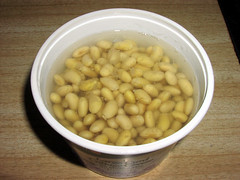
2. Soak the seeds for eight hours at room temperature (or put them into the fridge if you want to soak for longer). The picture shows soybeans and barley after soaking.

3. Once the seeds are soaked, drain off the excess liquid and place them into the filter basket.
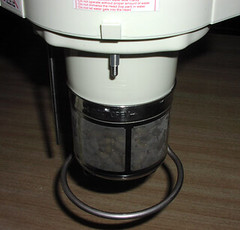
4. Attach the filter basket to the bottom of the grinding unit and ensure that it is locked on. [Note: If you have trouble attaching the filter basket because the seeds are large (e.g., almonds, hazelnuts) you can remove them from the basket and add them via a small slot on top after you've attached the basket.]

5. Fill the pitcher portion of the soy milk maker with water to the line on the side (~6 cups), and place the grinding unit into the pitcher portion. Start the unit.
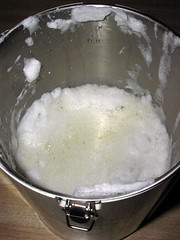
6. When the unit is finished (~15 minutes; it beeps) check to see how much foam is on the soy milk; if there is a lot of foam, run the unit through another heating cycle (we often have to do this for soy-based milks, but rarely for non-soy milks).
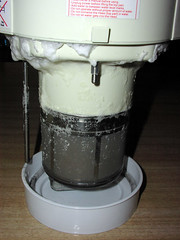
7. Remove the main unit from the pitcher and rest it on the stand that comes with the unit.
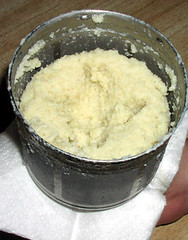
8. Using a paper towel (or other heat- and drip-protective device) remove the filter basket from the soy milk maker and empty out the ground nuts and grains. We save the grindings to make other tasty treats (ground soybeans (okara) make good vegetarian burgers, and ground nuts make good sweetened gruels).
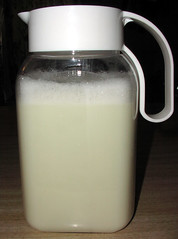
9. Pour the soy-barley milk into a jug and sweeten as desired. We typically add 1/8 cup (2 tablespoons) white sugar, 1/8 cup dark brown sugar, 1/2 teaspoon vanilla extract, and 1/4 teaspoon kosher salt.
10. Clean the unit. Do this immediately after using the unit, as the residue dries quickly. The included brush and "magic cleaning solution" are well worth using (the latter being especially useful to soak the filter basket in; we save the "magic cleaning solution" between batches).
11. Enjoy your soy-barley milk. We typically serve it chilled, but it's also good hot.
The most frustrating and time-consuming part of the process is the cleaning; the filter basket gets lots of little pieces of ground material lodged in its holes, the motor housing (which can't be immersed in water) gets covered in foam, and the grinder and heating element always have residue left on them. The cleaning takes about five minutes with the two of us working; it seems like a soy milk maker could be designed that would be much easier to clean (e.g., by making it dishwasher-safe). To help minimize the cleaning, we make two batches of non-dairy milk in a row, which allows us to only do a cursory cleaning after the first batch.
We've had good luck with nut, grain, legume, and drupe combinations other than soy-barley (more recipes to come later), but so far have found that both pure rice milk and rice-oat milk had an odd gluey texture that wasn't appealing.
The SoyaPower machine we purchased is available here, and is manufactured by Salinex.
[Updated September 26 to clarify a few points and fix some thinkos.]
Recipe



1 comment:
Importing comments:
Jan
they have come out with the SoyaPower Plus, with improvements you suggested. I read your review and wanted to buy a SoyaPower, but ended with the New SoyaPower Plus, and very happy with it!
April 18, 2009, 6:30:11 PM PDT – Like – Reply
Hal
Just toothbrush-off the filter under running water and store in an Oxyclean solution-it will be clean-as-new every time. We keep our two filters in coffee cans of solution to make a gallon every other day.
January 23, 2008, 11:28:16 AM PST – Like – Reply
Radagast
Glad the review was useful
We only have one filter basket, and thus re-use the same filter for both batches. To do this we dump out the ground and cooked soybeans (okara), briefly rinse the filter under running water (to get off the large bits of residue), and then re-load it with new soybeans. Since we don't try to get all the residue and little bits of stuff off, this cleaning is very fast. We only thoroughly clean the filter basket after the second batch has been made.
January 11, 2007, 7:50:35 PM PST – Like – Reply
Anthony
Thank you for taking the time to explain the soyapower. It is hard to get real good independent reviews so coming across yours was a real blessing. Also I would like to know if you make two batches in a row do you use an extra filter or the same one? And if it is the same one how do you manage this without cleaning it?
Again thank you for taking the time to share your experience.
Anthony
P.S.
As I was reading I was trying real hard to figure out what SO meant when it finally hit me. Significant Other.
January 11, 2007, 10:13:23 AM PST – Like – Reply
Radagast
We got it at The Container Store, after getting frustrated by our old containers. The jug does have a couple of gaskets that can get gunk stuck in them, but it can be fully disassembled and easily cleaned in the dishwasher.
February 7, 2006, 12:46:03 AM PST – Like – Reply
Ruth
Where did you get the jug that you put your soy milk in? Thanks for the cool sight!
February 6, 2006, 5:58:27 PM PST
Post a Comment